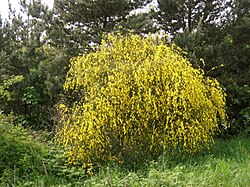Shrub
A shrub or bush is a category of plants. A tree usually has one stem, which at some height has branches. A shrub can have multiple stems from the bottom up. Usually, bushes do not grow as tall as trees, very often they are less than 1–2 m tall.

Very many plants can be either shrubs or trees, depending on the growing conditions. Small, low shrubs such as lavender, periwinkle and thyme are often termed subshrubs. Shrubs can be either deciduous or evergreen.
A shrubbery is a garden with shrubs as the main feature.
Shrubs as a botanical structural form
changeIn botany and ecology a shrub is more specifically used to describe the particular physical structural or plant life-form of woody plants which are less than 8 meters high and usually have many stems arising at or near the base.
For example, a descriptive system widely used in Australia is based on structural characteristics based on life-form, plus the height and amount of foliage cover of the tallest layer or dominant species.[1]
For shrubs 2–8 m high the following structural forms are categorized:
- dense foliage cover (70–100%) — closed-scrub
- mid-dense foliage cover (30–70%) — open-scrub
- sparse foliage cover (10–30%) — tall shrubland
- very sparse foliage cover (<10%) — tall open shrubland
For shrubs less than 2 m high the following structural forms are categorized:
- dense foliage cover (70–100%) — closed-heath
- mid-dense foliage cover (30–70%) — heath
- sparse foliage cover (10–30%) — low shrubland
- very sparse foliage cover (<10%) — low open shrubland
References
change- ↑ Costermans, L. F. (1993) Native trees and shrubs of South-Eastern Australia. rev. ed. ISBN 0947116761
Other websites
change- Selecting Shrubs for Your Home (University of Illinois Extension)